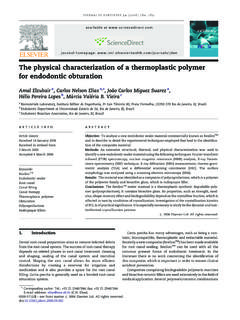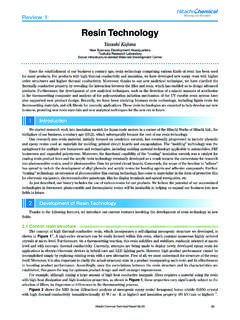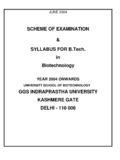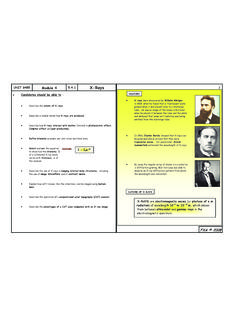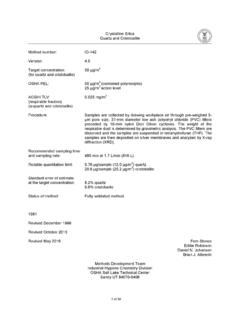Transcription of THE MEASUREMENT OF RESIDUAL STRESS WITH X-RAY …
1 AMMRC MS 83-1 . THE MEASUREMENT OF RESIDUAL STRESS with X-RAY diffraction CHARLES P. GAZZARA MATERIALS CHARACTERIZATION DIVISION May 1983 Approved for public release; distribution unlimited. ARMY MATERIALS AND MECHANICS RESEARCH CENTER Watertown, Massachusetts 02172 The findrngs In this report are not to be construI 3 as an official Department of the Army position, unless so designated by other authorized documents. Mention of any trade names or manufacturers in this report shall not be construed as advertising nor as an official indorsement or approval of such products or companies by the United States Government. DISPOSITION INSTRUCTIONS Destroy this report when It is no longer needed. Do not return I; to the or Iglnator. 3CL Rl I T LLr\33,r,Lm I , ly VT I n,a rrn L , V W YWS_ .YSYY, 1 REPORTDOCUMENTATION PAGE READ INSTRUCTIONS BEFORE COMPLETING FOI 1.
2 REPORT NUMBER 2. GOVT ACCESSION NO. 3. RECIPIENT S CATALOG NUMBER 1 MMRC MS 83-1 0. TITLE (end Subtitle) THE MEASUREMENT OF RESIDUAL STRESS with X-RAY diffraction fERED 5. TYPE OF REPORT 8 PERIOD CO\ Final Report 6. PERFORMING 07G. REPORT NUM BER 7. AU THOR(s) Charles P. Gazzara 6. CONTRACT OR GRANT NUMBER(a 1) 9. PERFORM!NG ORGANIZATION NAME AND ADDRESS 10. PROGRAM ELEMENT, PROJECT, AREA iL WORK UNIT NUMBERS TASK Army Materials and Mechanics Research Center Watertown, Massachusetts 02172 DRXMR-OM Il. CONTROLLING OFFICE NAME AND ADDRESS U. S. Army Materiel Development and Readiness Command, Alexandria, Virginia 22333 142 D/A Project: lL161102AP AMCMS Code: 61102A 12. REPORT DATE May 1983 13. NUMBER OF PAGES 45 14. MONlTORlNG AGENCY NAME 8 ADDRESS(if different from Controffing Office) 15. SECURITY CLASS. (of this report) Unclassified DING 15a.
3 DECLASSIFICATION DOWNGRAI SCHEDULE 16. DISTRIBUTION STATEMENT (of this Report) Approved for public release; distribution unlimited. 17. DISTRIBUTION STATEMENT (of the abstract entered i-: Ljlock 20, if different from Report) 18. SUPPLEMENTARY NOTES Much of the material presented in this report is the result of research (6. and Materials Testing Technology (MTT) projects conducted at AMMRC and was presented at a seminar at the Naval Air Rework Facility in San Diego, Calif on 18 and 19 November, 1981. 9. KEY WORDS (Continue on reverse side if necessary and identify by block number) RESIDUAL STRESS Nondestructive testing X-RAY analysis Instruction manual X-RAY diffraction 10. ABSTRACT (Continue on reverse side If necessary and identify by block number) (SEE REVERSE SIDE) DD FWl-7M 1 JAN 73 1473 EDITION OF 1 NOV 65 IS OBSOLETE UNCLASSIFIED SECURITY CLASSIFICATION OF THIS PAGE (When Date Ektered) UNCLASSIFIED SECURITY CLASSIFICATION OF THIS PAGEWI-J Dmta Entered) , + 1 Block No.
4 20 ABSTRACT A concise summary of the application of X-RAY diffraction principles in- volved in the MEASUREMENT of RESIDUAL stresses is presented for those users of this technique having little exposure to this field. The latest developments in X-RAY diffraction RESIDUAL STRESS analysis, XRDRSA, are applied in simplified form so that this report can serve as a working manual. Five general areas are considered, namely: theory, history and progress, technical problems, apparatus, and examples of specific problems involving the MEASUREMENT of RESIDUAL stresses using X-RAY diffraction procedures. Much of the material presented is the result of research ( ) and Materi- als Testing Technology (MTT) projects conducted at AMMRC and was presented at a seminar at the Naval Air Rework Facility in San Diego, Calif. on 18 and 19 November, 1981.
5 UNCLASSIFIED SECURITY CLASSIFICATIOU OF TLJ~= AGEP ~~~ Data Enter@< CONTENTS Page FOREWORD INTRODUCTION .. 1 THEORY .. 1 Origin of X-rays .. 2 diffraction Planes (hkl) .. 3 diffraction .. 4 RESIDUAL STRESS .. 4 X-RAY Safety .. 10 HISTORYANDPROGRESS .. 11 TECHNICAL PROBLEMS .. 14 Texture .. 16 GrainSize .. 21 Surface Distortion .. 22 27 diffraction Geometry .. 31 High-Speed Systems .. 32 Single-Exposure Method .. 32 Multiple-Exposure Method .. 36 Future Systems .. 36 Detection .. 36 Intensity .. 36 APPLICATIONS .. 36 Standards .. 36 REFERENCES .. 41 ___ _ FOREWORD The purpose of this report is to provide a concise, current, and simple working manual on X-RAY diffraction RESIDUAL STRESS analysis (XRDRSA). This material is directed towards the field user who has neither the manpower nor the time to commit for application of a technique that is, at present, accepted to be the most accurate means of determining RESIDUAL stresses nondestructively in the surface of a crystal- line material.
6 For those laboratories, such as at AMMRC, which possess a balance of research ( ) and the applied state-of-the-art ( , MTT), this report may be use- ful to the applications engineer and also to the technical manager, whose responsi- bility encompasses a rather broad scope. However, in many industrial settings and military installations, which are directed to apply the test methods in a challeng- ing array of diversified field problems, this report will probably be most useful. The area of XRDRSA is in a state of evolutionary flux. While much apparatus is developing rapidly, and indeed is being used in many field settings, many technical problems associated with some of these applications are under investigation and being reported in technical journals. Indeed, this points out what price is to be paid for leaving technical gaps in the development of methods, such as in the area of XRDRSA.
7 The need for this presentation suddenly climaxed with a technical consulting visit to the Naval Air Rework Facility, NARF, in San Diego, Calif. on 18-19 November, 1981. Essentially, most of the contents of this report were presented to a group, with broad backgrounds, at NARF. It was at the suggestion of Mr. Jeff Sakai, who painstakingly arranged the seminar, that this report be written, since the contents of which are finding their way to an interested audience in a rather loose and somewhat disjointed form. - II INTRODUCTION The format of this report will consist of five sections, namely: (1) Theory The theoretical background will be given in short and simplified form. In some cases the treatment of the material will only serve to "define" the terms used in the subsequent presentation. (2) History and Progress This section, almost always neglected in papers on this subject, may serve to afford an understanding of the present conditions in the field of XRDRSA as well as an appreciation of the attention given to particular aspects of the methods involved.
8 (3) Technical Problems The primary problem areas associated with XRDRSA are with grain size, surface conditions, and texture, or preferred orientation. These problems are reviewed and examples given; illustrating the extent of these effects and how to correct for them. (4) Apparatus A comparison STRESS is given; i of the X-RAY equ llustrating the ipmen t deve impor tant f loped and applied in measuring RESIDUAL eatur es of the app aratus available. (5) Applications Examples of applications of XRDRSA to specific problems will be discussed along with the approach taken to avoid or solve them. It is intended that the steps taken in arriving at solutions will serve as guidelines towards a systematic, and hope- fully efficient, approach to applying XRDRSA to a wide range of field problems. THEORY' The term diffraction , taken literally, means "break into pieces.
9 " From the wave theory of light, which was well established before X-rays were known to exist, light waves scattered from gratings, or lines, were known to "interfere" destruc- tively and yield no light, while others interfered constructively and gave intense light patterns or fringes. Since gratings could be made with separation distances the same as the wavelength of light (the wavelength of light, approximately 3000 A, is roughly equal to the separation of grating spacings produced mechanically [o 1 -5 in.]) light diffraction was simple to achieve. 1. CULLITY, B. D. Elements of X-RAY Dif;;action, Addison Wesley, Reading, Massachusetts, 1967, in-depth presentation of the following theory of X-RAY diffraction and RESIDUAL STRESS analysis, a more Max von Laue, in 1912, with a single stroke of creativity, reasoned that X-rays have the same wavelength as the separation distances of one of the most accurate gratings available.
10 Furthermore, these gratings are available in nature and can also make use of the penetrating power of X-rays. These gratings are the crystal lattice of crystalline materials. Thus, it became possible to obtain the first three-dimensional diffraction of "waves" or X-rayss2 Hence, the field of X-RAY diffraction , of which XRDRSA is a small segment, can be traced to this idea. Origin of X-rays X-rays, as electromagnetic waves, can be produced as a result of an atomic reaction or a "radiation event". The way that X-rays are created for almost all work performed in XRDRSA, is by utilizing the physical phenomenon that if an elec- tron is given sufficient kinetic energy and is brought to a sudden stop, X-rays will be produced. Since electrons travel relatively unimpeded in a vacuum, X-RAY tubes are vacuum tubes.












